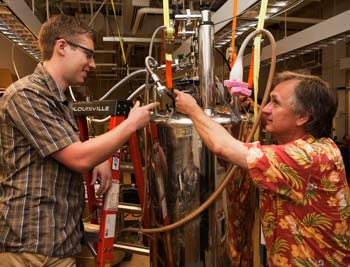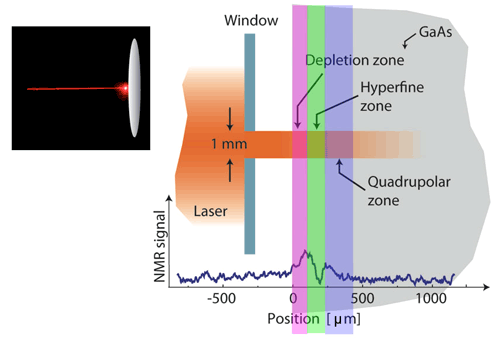Chemical engineers use lasers to put new spin on computing

How much longer can we take for granted the continued evolution of faster, better and cheaper electronic devices? The laptops and smart phones we carry with us today have more computing power than many of the massive mainframe computers that helped guide humans to the moon in the late 1960s. But today’s miniaturized and complex computer chips are beginning to reach their physical limits. At UC Berkeley and the City College of New York, researchers are working together on techniques to sidestep these limits to encourage the creation of the next generation of even faster and smaller electronic devices.
In a recent article in Nature Communications, City College of New York’s Carlos Meriles and Yunpu Li, along with UC Berkeley’s Jeff Reimer and Jonathan King, are using lasers to control the fundamental nuclear spin properties of semiconductor materials. Their laser techniques will speed the creation of “spintronic” devices that use the spin state of electrons to control the memory and logic circuits that are the heart of modern computers.
“But,” Reimer says, “We have even bigger fish to fry. We can use these same laser techniques to manipulate spin states for a radically new type of computing. For now, ‘quantum computing’ relies on expensive, exotic materials or on temperatures very close to absolute zero. Our laser techniques can allow quantum computing to become far more practical and inexpensive. With lasers, this research can be conducted with standard semiconductor materials.”
For many years, advances in computer chips have followed Moore’s Law. Named for Intel co-founder Gordon Moore, Moore’s Law states that the number of miniaturized transistors that can be placed on a computer chip of a given size doubles every 18 months. Today’s computer chips require details on the scale of 28 nanometers. A nanometer is a billionth of a meter. For comparison, a human hair is 100,000 nanometers wide. Unfortunately, at this scale, electrons begin misbehaving. They tend to jump between wires almost as readily as they travel along wires. Today’s computers are reaching the limits of what simple miniaturization can achieve.
Says Reimer, “This is where spin comes into play. Spin is the characteristic of the neutrons, protons and electrons that make up all matter. It is spin that allows us to get images inside the human body using magnetic resonance imaging (MRI). Although spin is part of the world of quantum mechanics that physicists began to explore in the early 1900s, the effects of spin in bulk matter weren’t discovered until after World War II.”
To conceptualize spin, imagine an electron, proton or a neutron spinning about its axis like a top. The axis itself is a tiny bar magnet. In the world of quantum mechanics, spin is described as being either up or down, not north or south. These spin states can be aligned either spin up or spin down by powerful magnetic fields.
“When your doctor orders an MRI exam,” says Reimer, “you are placed inside the doughnut of an MRI machine, where powerful superconducting magnets align the spin states of the water molecules in your body. Precise pulses of radio waves temporarily knock the spin states out of alignment, causing the hydrogen atoms in your body’s water molecules to wobble like miniature tops. As the atoms realign themselves with the magnetic field of the MRI machine, they give off a telltale resonant radio frequency that allows the MRI technician to trace the location of different tissue types in your body.”
Reimer is an expert in using a related technique, nuclear magnetic resonance (NMR) to reveal the properties of catalysts and semiconductor materials. Says Reimer, “Society has spent billions of dollars developing MRI and NMR imaging techniques to a very high level of sophistication. Now we want to use this knowledge to develop better spintronic devices, electronic devices that are controlled by manipulating the spin state of their atoms. This isn’t science fiction,” he adds. “Most of us are already using one device that is based on spintronics—the hard drive inside of computers, which relies on a spintronic effect called giant magnetoresistance.

“We’d like to see spintronics move beyond memory devices to the logic circuits that are the heart of modern computers. The problem is that the magnets used by MRI and NMR machines can be huge, sometimes two stories tall or more. If we try to build these magnets into computer chips, we are right back to the same old miniaturization problem we are trying to solve. Fortunately, we can do an end run around the problem by using lasers.”
Reimer and colleagues have discovered that they can use circularly polarized laser beams to control spin states in the semiconductor material gallium arsenide. “Circularly polarized light moves forward either clockwise or counterclockwise, like the threads on a bolt, or a corkscrew. By tuning the laser to just the right intensity and frequency, and by picking the isotopes of gallium and arsenic we use for the semiconductor material, we can control the spins in the semiconductor by using polarized laser light. Best of all, we don’t have to build any miniature electromagnetic devices onto the chip. For our research we use off-the-shelf lasers designed for light shows. They work just fine.”
With spintronics, the spin state of electrons is used to control how the electrons shuttle through the logic gates that make up the billions of transistors on a computer chip. Spintronics can allow computer chips to operate more quickly and with lower power, but ultimately, the nature of the computer remains conventional. What if the spin states themselves could be used for computing operations?
“Quantum computing is one of the holy grails of science and engineering,” says Reimer. “In conventional computing, we use the charge of electrons, either positive or negative, to encode either a zero or one. That’s a ‘bit,’ the basic building block of digital calculations. We can also encode a zero or one in the up or down spin state of an electron. That’s a ‘qubit,’ or quantum bit. It turns out that quantum bits, due to their quirky quantum nature, actually have advantages over standard bits. The trouble is building devices that can accurately read, write and flip qubits.”
The problem that Reimer and co-authors are trying to overcome is noise. “At the atomic scale,” he says, “the world of qubits is extremely noisy. We might be trying to conduct logic operations by flipping the spins on a handful of electrons. Meanwhile, we are surrounded by millions of nuclei whose spins are flipping up and down in a very random way, obscuring the signal.”
There are ways to quiet the spins and make them more orderly, but existing techniques are very difficult and expensive. One is to cool down the semiconductor to very close to absolute zero, where the random spins settle down into more orderly patterns. Another technique is to synthesize material that is naturally ‘spin quiet.’ The leading candidate for this is artificial diamond made from materials that contain only the spinless isotope, carbon-12.
Says Reimer, “Both these options are so expensive and difficult that the amount of quantum computing research that can be conducted will be very limited. Using circularly polarized laser light may prove to be a cost-effective alternative. With our laser technique, we have been able to create regions in semiconductor material where the spins stay aligned over micrometer-scale regions for minutes to hours. In effect, we have used lasers to create a ‘spin freezer’ in a tiny and specified region in space. We hope our spin freezing technique serves as the basis for new developments in spintronics and quantum computing.”
Adds co-author King, a Ph.D. candidate in the Reimer lab, “We envision using the intrinsic magnetic field of the nuclei to gain three-dimensional control of electron spins on microscopic length scales. Instead of being a source of unwanted noise, the nuclei can be organized into a valuable tool for spintronic devices.”
